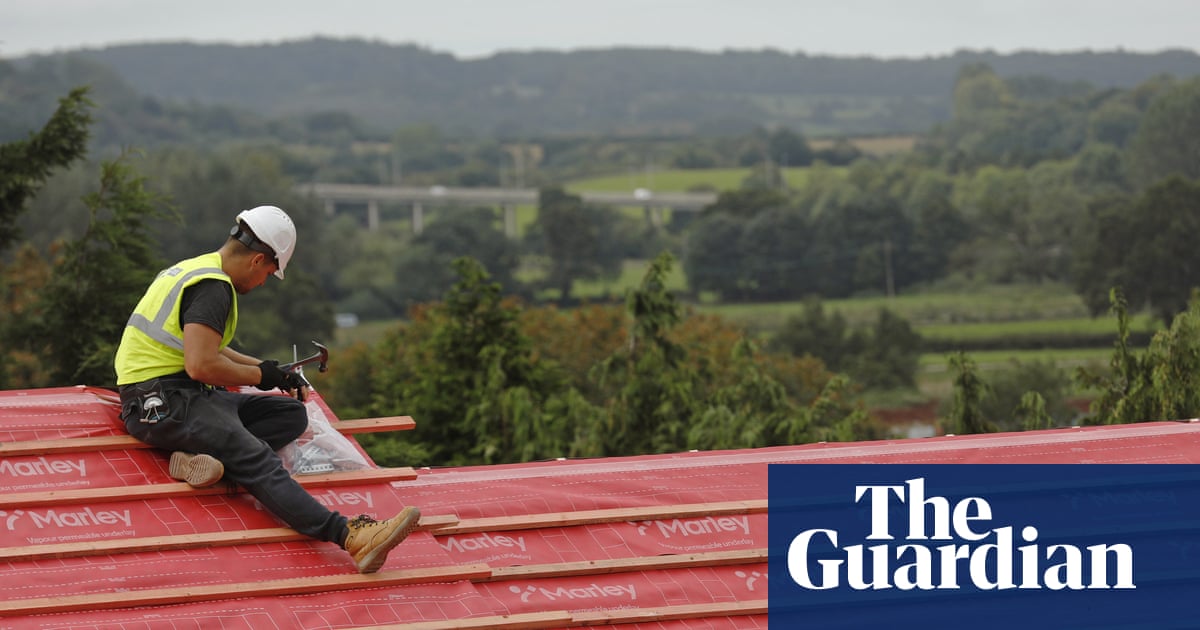
Housebuilding in England is due to fall to its lowest level since the second world war, according to an analysis by the Home Builders Federation (HBF), owing to a range of government policies that threaten to dramatically slow development.
The study says the supply of new housing is likely to fall below 120,000 homes annually over the coming years, less than half of the government’s target, as a result of changes to planning policy and what developers say is over-strict enforcement of environmental regulations.
The drop will leave England with a huge shortfall of new homes, the HBF warned, exacerbating the country’s housing crisis and making it harder than at any point in recent history to become a homeowner.
Stewart Baseley, the executive chairman of HBF, said: “The increasingly anti-development and anti-business policy environment poses a real threat to housebuilding and is inevitably at the forefront of minds when investment decisions are being made.
“As we try to tackle the housing crisis during a recession, with tighter mortgage availability and no government scheme to assist buyers purchase new builds for the first time in decades, short-term political decisions to appease backbenchers seriously threaten confidence.”
A spokesperson for the Department for Levelling Up, Housing and Communities said: “We do not accept this analysis. We remain committed to delivering 300,000 new homes per year remains and we are investing £11.5bn to build the affordable, quality homes this country needs.”
The predicted drop comes after years of rising housing supply spurred in part by the Conservative-Liberal Democrat coalition’s adoption in 2012 of the national planning policy framework (NPPF), designed to stop councils blocking large numbers of new developments. As a result, net new housing supply doubled over the next seven years.
Last year, however, Michael Gove, the secretary of state for levelling up, housing and communities, came under heavy pressure from backbench Conservative MPs to make changes to the NPPF that would make it easier for local authorities to refuse planning permission. Many in the party believe local planning disputes contributed to the Conservatives losing the Chesham and Amersham byelection in 2021.
Gove caved to those demands in December, announcing he would drop the government’s compulsory target of building 300,000 new homes each year, making it voluntary instead. This was despite the party having said in its 2019 manifesto that the compulsory target was “central to our levelling up mission”.
Around the same time, Gove also dropped the requirement for councils that have up-to-date housing plans to show they also have enough land for five years’ worth of new building.
Almost as soon as those changes were made, local authorities began pausing or reducing their local housebuilding plans, with 47 having done so already. Those authorities include the local council in Gove’s own constituency, Surrey Heath, which announced earlier this month that as a result of his decision, it would no longer consider four sites for development.
The HBF analysis found that the cumulative impact of councils responding to the changes would lead to 77,000 fewer homes being built every year.
Matthew Pennycook, the shadow housing minister, said: “This report lays bare the enormous cost of Rishi Sunak and Michael Gove’s reckless decision to hastily overhaul national planning policy in the face of backbench pressure. By putting party before country and consciously accepting that fewer houses will be built in England over the coming years as a result, they have chosen to deepen the housing crisis and hammer economic growth.”
The other main impediment to new building, say developers, is a legal requirement by Natural England that new homes should not add damaging nitrates or phosphates to nearby waterways. This rule requires developers to prove their buildings will be “nutrient neutral” before being granted planning permission for sites close to rivers or other protected sites.
As a result, HBF calculates that 120,000 new homes have been put on hold, with a further 41,000 at risk every year if the issue is not resolved soon. Developers say the rule is unfair because farming is the main contributor to excess nutrients in waterways, along with sewage treatment plants.
A spokesperson for the Department of Environment, Food and Rural Affairs said: “Nutrient neutrality mitigation rules aim to reduce pressure on our rivers while supporting the development of the sustainable homes we need.”
No 10 recently hosted a round table with developers to try to resolve the issue, giving the industry some hope they will be given leeway on the rules before long.
Natural England is getting in the way of new housebuilding in other ways as well, HBF claimed, including by requiring that planners take into account whether new developments would put “recreational pressure” on certain sites such as national parks because more local residents would visit them.











